Physical Address
304 North Cardinal St.
Dorchester Center, MA 02124
Idiopathic disorder that can affect the skin, hair, nails, and/or mucosae (oral, vulvovaginal) and most commonly affects adults.
May represent a T-cell-mediated autoreactive disorder against keratinocytes whose self-antigens have been altered by trauma or infection (e.g. HCV).
Flat-topped (lichenoid) papules that are often polygonal in shape and purple in color may coalesce into plaques ( Fig. 9.1 ); lesions usually resolve with hyperpigmentation ( Fig. 9.2 ).

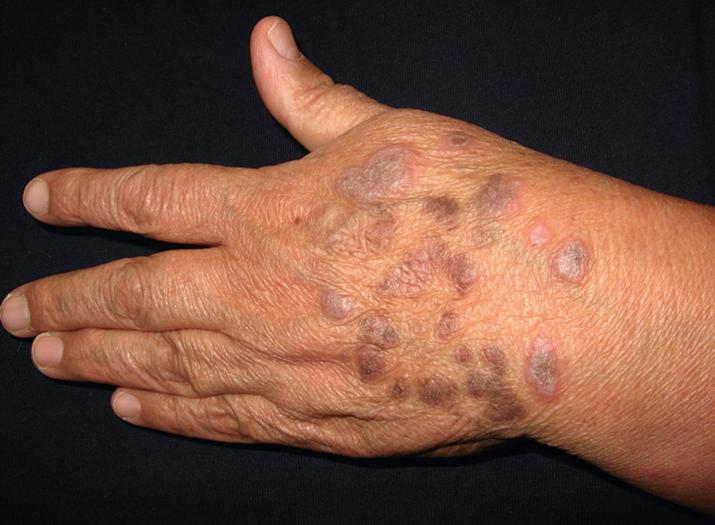
A characteristic finding is Wickham striae, a network of fine white lines on the surface of papules and plaques ( Fig. 9.3 ).
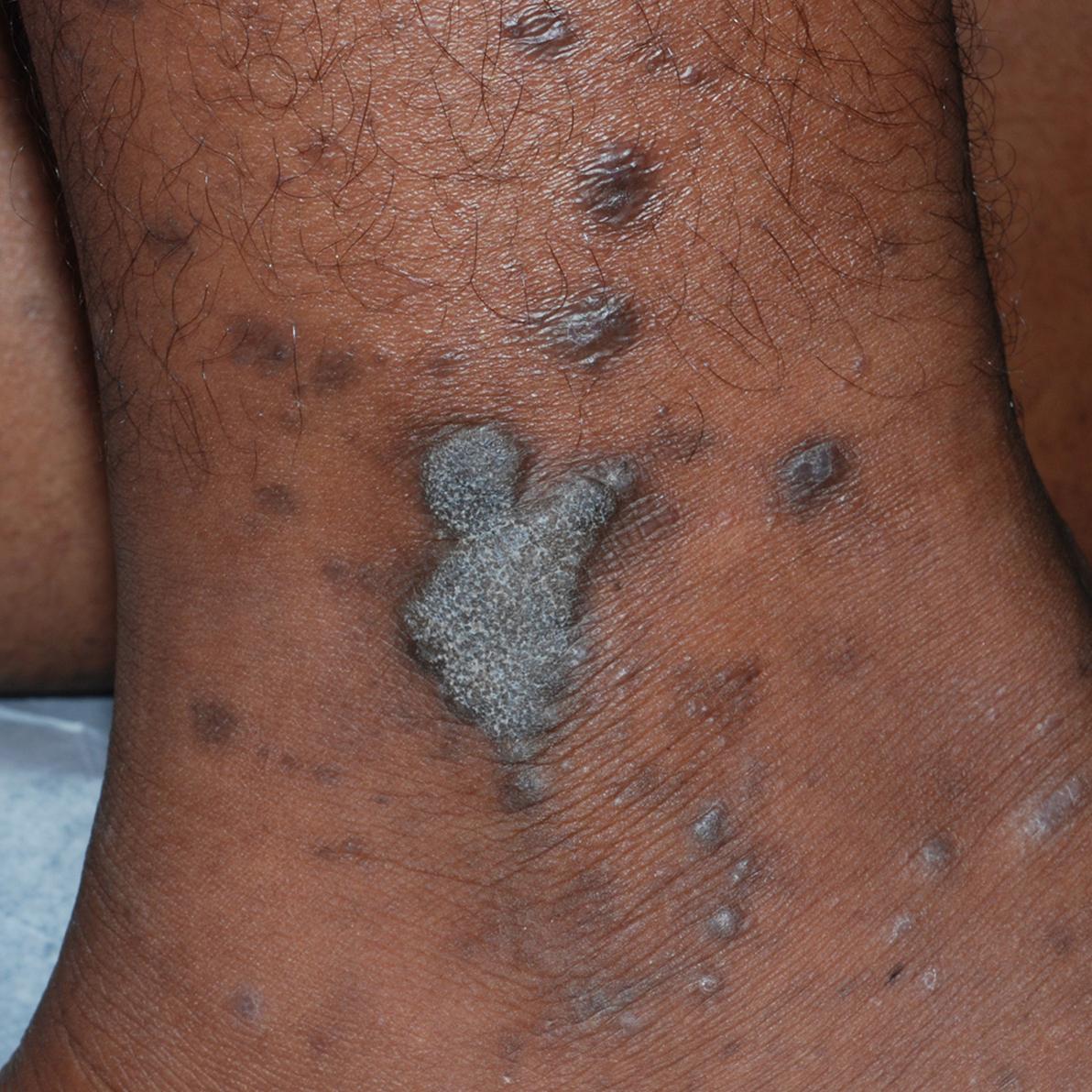
The most common cutaneous sites of involvement are the scalp, flexor wrists ( Fig. 9.4 ), forearms, genitalia, distal lower extremities, in particular the shins, and presacral areas.
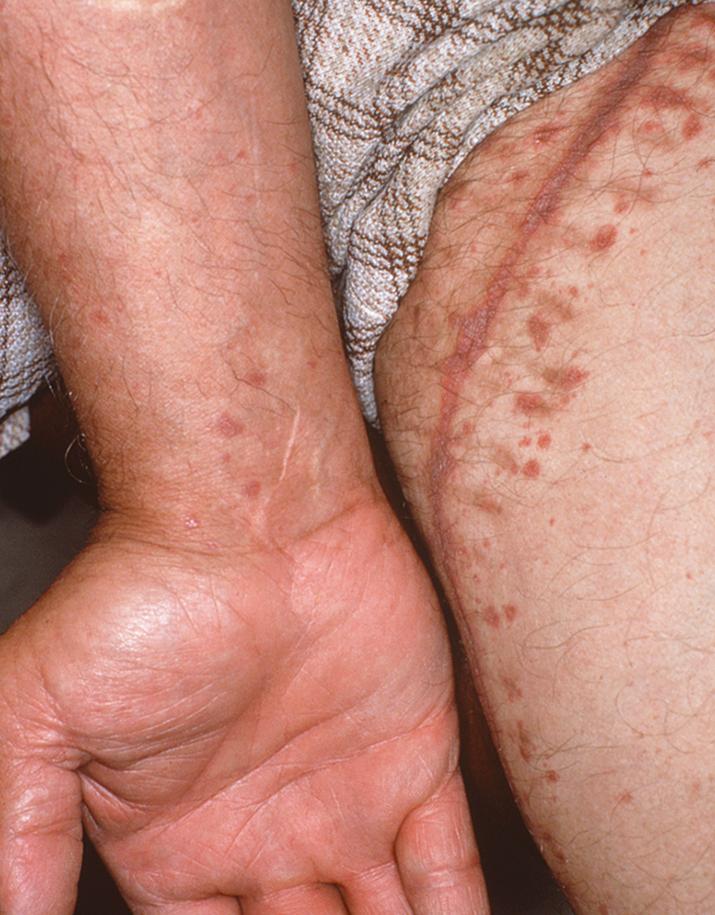
There are multiple variants of lichen planus, from exanthematous to hypertrophic ( Table 9.1 ; Figs 9.5 and 9.6 ).
| Type | Clinical aspects | Comments |
|---|---|---|
| Actinic LP | Sun-exposed sites, especially face, neck, dorsal aspect of arms Red-brown annular plaques or melasma-like appearance |
Middle East Young adults, children |
| Acute (exanthematous; eruptive) LP ( Fig. 9.5 A) | Abrupt onset Widespread distribution |
Usually self-limited (3–9 months) Exclude lichenoid drug eruption, pityriasis rosea, secondary syphilis |
| Annular LP ( Fig. 9.5 B) | Thin raised border, with hyperpigmented or skin-colored center | Favors axillae, groin/penis, extremities |
| Atrophic LP ( Fig. 9.5 C) | Large plaques with epidermal atrophy Later stage of disease |
DDx: lichen sclerosus Annular variant with loss of elastic fibers centrally |
| Bullous LP ( Fig. 9.5 D) | Bullae within pre-existing lesions | Separation of epidermis from dermis with underlying lichenoid lymphocytic infiltrate |
| Hypertrophic LP ( Figs 9.3 & 9.5 E) | Favors shins and dorsal feet Thick pruritic plaques with scale Can develop SCC |
Average duration – 6 years DDx: lichen amyloidosis, LSC, rupioid psoriasis |
| Inverse LP ( Fig. 9.5 F) | Violaceous plaques Axillae > inguinal or other major body folds |
Overlap with LP pigmentosus as lesions resolve with hyperpigmentation |
| LP pemphigoides | Variable distribution of vesicobullae, including previously uninvolved skin | Routine histopathology and DIF of bullous lesions – similar to BP; IIF: autoAb to BPAG2 |
| LP pigmentosus ( Fig. 9.5 G) | Brown to gray-brown macules and patches in sun-exposed areas of the face and neck or intertriginous zones Inflammatory phase usually absent |
Skin phototypes III and IV Coexisting LP lesions in 20% of patients DDx: erythema dyschromicum perstans, resolved inverse LP |
| Lichen planopilaris (see Ch. 56 ) | Keratotic plugs within hair follicles with narrow surrounding red to violet-colored rim Hair-bearing sites, especially the scalp |
A form of scarring alopecia Variant – frontal fibrosing alopecia (see Ch. 56 ) DDx for scalp: discoid LE |
| Linear LP ( Fig. 9.5 H) | Need to distinguish Koebner phenomenon from lesions following lines of Blaschko | See Chapter 1 , Chapter 51 DDx: lichen striatus if along lines of Blaschko |
| LP/LE overlap | Lesions favor acral sites Overlapping features |
Spectrum – from only cutaneous LE to systemic LE |
| Nail LP ( Fig. 9.6 A,B); (see Ch. 58 ) | Lateral thinning, longitudinal ridging, fissuring Dorsal pterygium |
Variant – twenty-nail dystrophy (more common in children) |
| Oral LP ( Fig. 9.6 C,D) | Reticular form – white lacy lines or circle with short radiating spikes (buccal mucosa) Erosive form ∗ – includes chronic desquamative gingivitis |
Patients can have both gingival and vulvovaginal involvement May be associated with HCV infection |
| Ulcerative LP | Plantar surface > palms | |
| Vulvovaginal LP (see Ch. 60 ) | Inner aspects of labia minora Glazed erythema that easily bleeds |
DDx: lichen sclerosus |
∗ If erosive variant plus lichenoid cutaneous lesions, DDx includes paraneoplastic pemphigus.
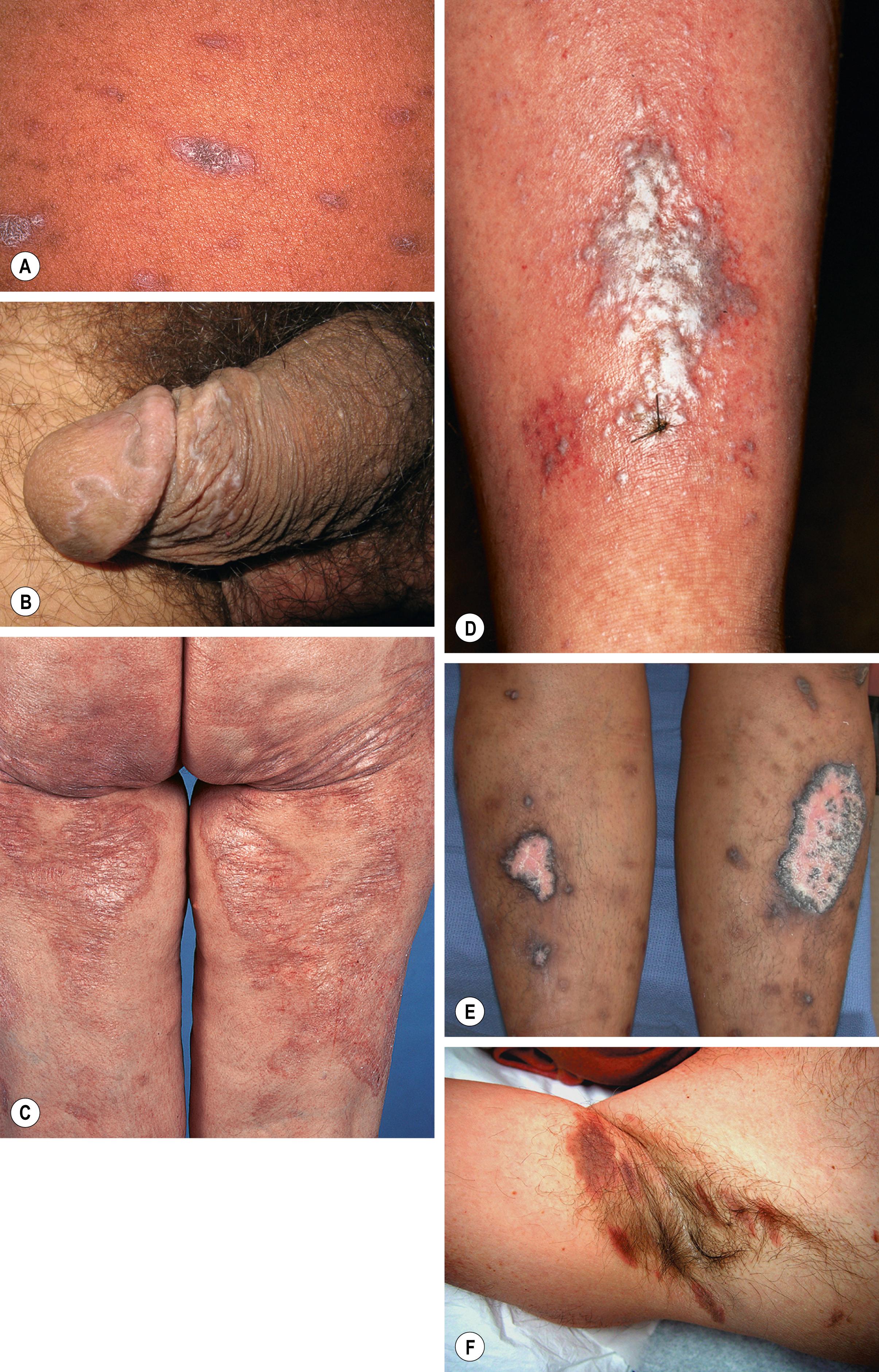
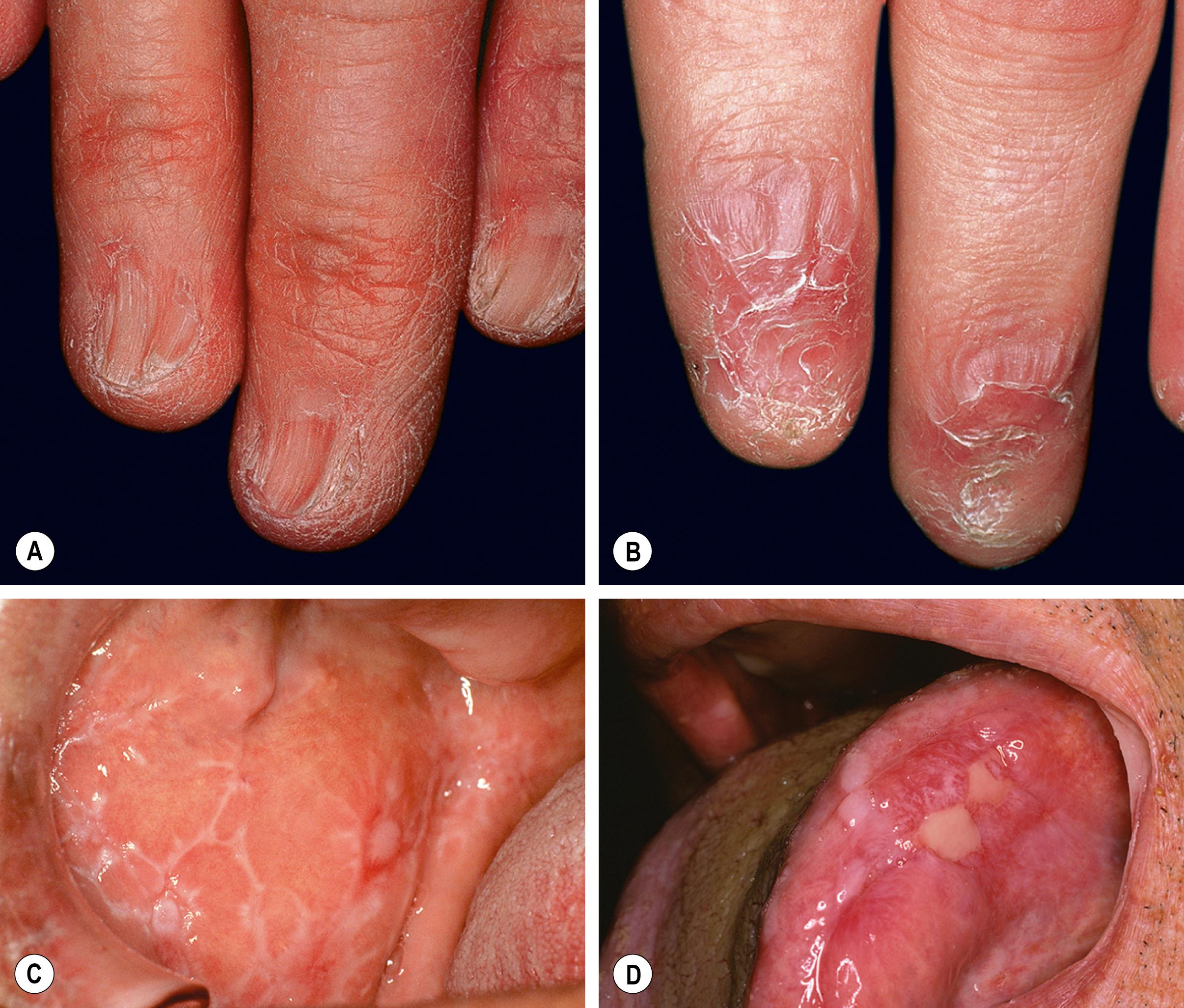
Histologically, a band-like infiltrate of lymphocytes is seen in the upper dermis abutting the epidermis, with apoptosis of keratinocytes (Civatte or colloid bodies) and hypergranulosis; the outline of the lower aspect of the epidermis may be sawtooth-like and melanophages are present in the upper dermis.
DDx: lichenoid drug eruption, lupus erythematosus, pityriasis lichenoides chronica, lichen nitidus, GVHD, and a lichenoid “id” reaction due to acute contact dermatitis to nickel (children), as well as the entities in the comments section of Table 9.1 .
Rx: topical or intralesional CS, topical calcineurin inhibitors, phototherapy (NB-UVB), and if severe, consider systemic therapy, e.g. oral CS, hydroxychloroquine [scalp disease], acitretin, JAK inhibitors, apremilast. Topical options for oral lichen planus are outlined in Table 59.2 .
A drug-induced eruption that has an appearance similar to lichen planus; frequently more generalized or in a photodistribution (e.g. HCTZ-induced [ Fig. 9.7 ]).
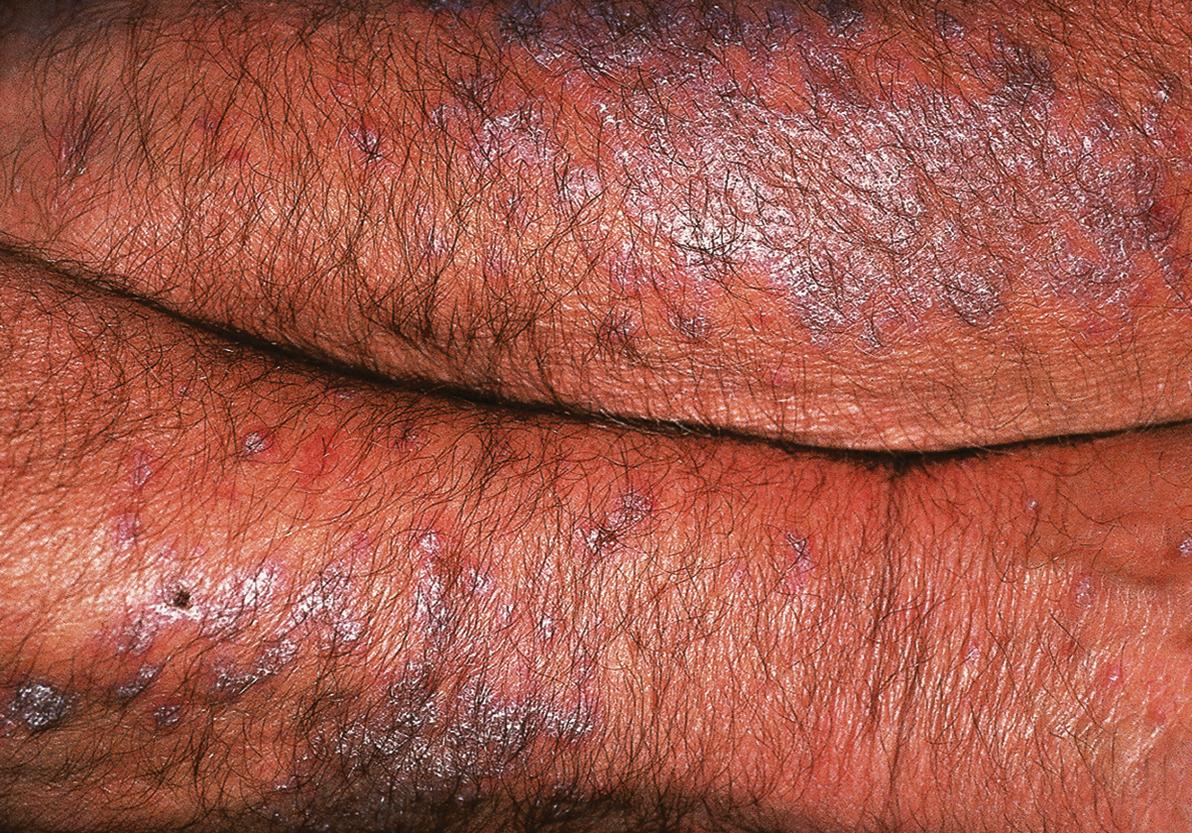
Often a latent period of months after instituting drug.
Lesions tend to be more eczematous, psoriasiform, or pityriasis rosea-like.
Most commonly incriminated drugs are angiotensin-converting enzyme (ACE) inhibitors, thiazide diuretics, antimalarials, β-blockers, TNF inhibitors, quinidine and immune checkpoint inhibitors (e.g. nivolumab).
Despite discontinuation of the offending drug, the eruption may be persistent, requiring treatments employed for lichen planus (e.g. topical corticosteroids).
Become a Clinical Tree membership for Full access and enjoy Unlimited articles
If you are a member. Log in here